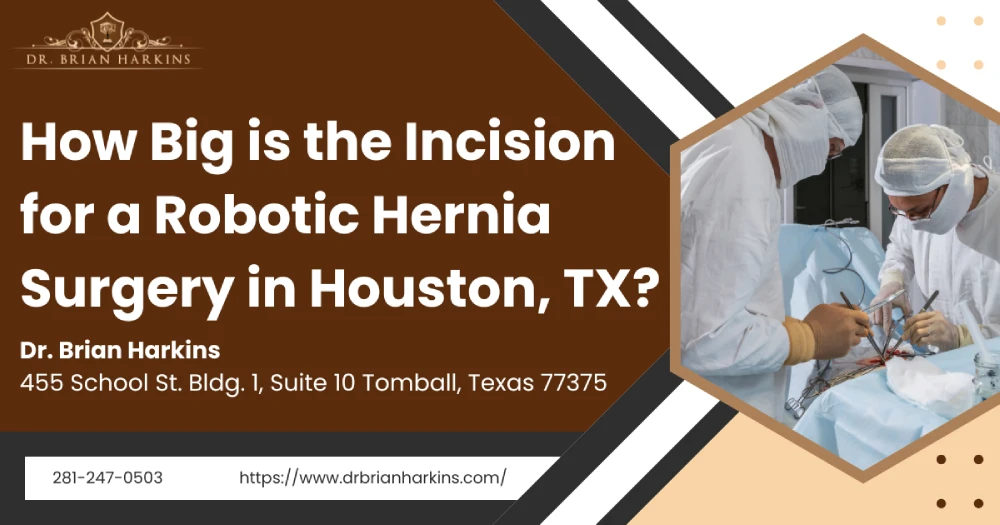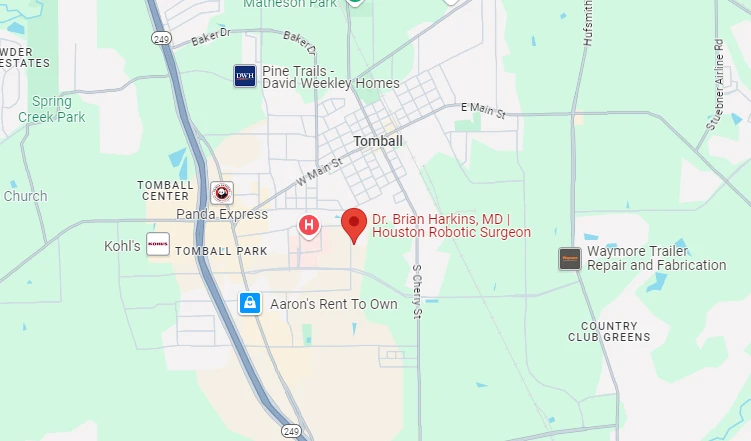
When exploring your options for hernia treatment, you might ask: how big is the incision for a robotic hernia surgery in Houston, TX? The answer is reassuring—these procedures typically use several small 8 mm ports instead of a single large incision. These pencil-thin entry points are part of a minimally invasive approach that allows Houston surgeons to use robotic arms for high-precision mesh placement while minimizing trauma to the abdominal wall. This advanced technique—often performed with the da Vinci robotic system—helps reduce pain, lower the risk of infection, and speed up recovery.
| Technique | Typical Number of Incisions | Average Incision Width | Total Skin Opening Length | Scarring & Recovery Highlights |
|---|---|---|---|---|
| Open Hernia Surgery | 1 | 3–6 in | 3–6 in | More pain, higher infection risk, visible scar |
| Traditional Laparoscopic Hernia Repair | 3–4 | 5–12 mm | 15–20 mm | Moderate discomfort, limited scarring |
| Houston Robotic Hernia Surgery | 3–5 | 8 mm | 24–40 mm | Minimal pain, tiny scars, fastest return to activity |
The da Vinci Surgical System is an advanced robotic platform with multiple articulated arms. During robotic-assisted surgery, your surgeon sits at a console, manipulating those arms while a 3-D laparoscope projects an enlarged, high-definition view of the surgical area. The result: precise suturing, accurate mesh placement, and significantly lower hernia repair pain immediately after the procedure.
Most Houston surgeons place:
An inguinal hernia in the groin may need only three ports, while an umbilical, ventral, or hiatal hernia could require an extra assistant port. Inguinal hernia repair tends to be faster because the defect is smaller and easier to access with the robotic arms.
Higher BMI means thicker abdominal wall fat. Surgeons therefore space ports a bit farther apart and may choose extended-length cannulas—yet each cut stays 8 mm. The robotic system still maintains dexterity and vision, helping deliver effective hernia repair even in plus-size patients.
From check-in to discharge, most Houston robotic hernia surgeries last under eight hours door-to-door:
Use silicone gel, stay hydrated, and protect from sun. These steps reduce pigment changes, making the already tiny scars virtually invisible.
Not every facility offering Houston robotic hernia surgery has the same experience. Look for a team of hernia specialists who perform at least 50 robotic hernia repairs a year and who are comfortable managing complications after hernia surgery should they arise. Although many patients hear about North Texas Surgical Specialists, Houston has its own high-volume centers equally skilled in robotic surgical techniques and personalized care.
Robotic hernia repair surgery in Houston relies on multiple 8 mm ports—an exceptionally small incision size that minimizes trauma and speeds healing. Thanks to robotic technology, most patients experience less pain, reduced risk of infection, and a swift return to normal activities. Consult an expert hernia surgeon to discuss your treatment options for a hernia and determine whether this form of minimally invasive laparoscopic surgery is right for you.
Robotic hernia surgery in Houston generally involves three to five tiny incisions, each about 8 mm wide. These small ports replace the need for a large cut, helping patients recover faster, experience less pain, and reduce visible scarring. The size and placement may vary slightly depending on the type of hernia and individual anatomy, but the goal is always a precise, minimally invasive repair.
Most private insurers and Medicare recognize robotic-assisted hernia repair as a standard procedure when medically necessary. Coverage is similar to laparoscopic surgery, although your out-of-pocket costs depend on co-insurance, deductibles, and the hospital’s contractual rates.
Absolutely. The console surgeon can move the camera and robotic arms across the midline without creating extra incisions. Repairing both sides in a single session reduces anesthesia exposure and may lower overall recovery time compared with staged operations.
Mesh provides a durable reinforcement layer across the abdominal wall, distributing tension away from sutures. Modern lightweight, porous materials encourage tissue ingrowth, producing a sturdy yet flexible repair that significantly cuts recurrence rates versus suture-only closures.
Bulging near the groin or navel, aching discomfort after lifting, a feeling of pressure in the abdomen, or sharp pain when coughing all point to a possible hernia. Persistent or enlarging bulges warrant prompt evaluation by a hernia specialist to prevent emergency complications.
Most patients resume driving within three to five days, provided they are off prescription pain medications and can safely perform an emergency stop. Always confirm with your surgeon, as individual recovery times may vary based on the size and location of the hernia.
No surgery is risk-free. While robotic techniques lower infection and bleeding rates, potential issues such as seroma, mesh infection, or chronic groin pain can still occur. Choosing an experienced robotic surgeon helps keep these risks to a minimum.
Athletes benefit from the enhanced dexterity of robotic arms, allowing more precise mesh placement around critical muscles. Studies show faster core-strength recovery and reduced downtime, making robotic repair a popular choice for those eager to return to training quickly.
The procedure typically requires general anesthesia with endotracheal intubation to keep the lungs inflated during abdominal insufflation. Modern agents allow rapid wake-up, minimal nausea, and fast discharge home the same day in most elective cases.
Yes. Using similar 8 mm ports, surgeons can close the diaphragmatic defect and wrap the stomach (Nissen fundoplication) to control reflux. Recovery parallels other minimally invasive hernia repairs, with many patients eating soft foods within 24 hours.


Dr. Brian Harkins is a renowned surgeon specializing in advanced, minimally invasive, and robotic surgical techniques. With a dedication to innovation and personalized patient care, he has transformed countless lives by delivering exceptional outcomes.

I want a website like this, where do i start?